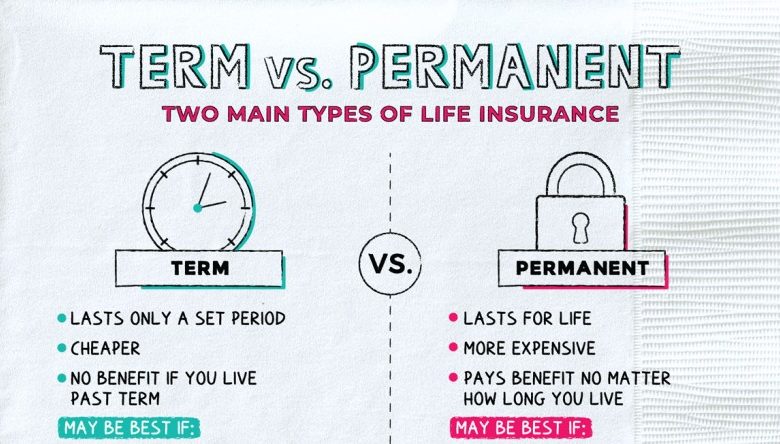
Term Life Insurance vs. Permanent Life Insurance: A Comprehensive Guide to Choosing Your Financial Safety Net:
Navigating the world of life insurance can feel like learning a new language, filled with complex terms and crucial decisions. At the heart of this landscape lies a fundamental choice: should you opt for term life insurance or permanent life insurance? This decision is one of the most significant you’ll make for your long-term financial plan, directly impacting your family’s security and your own financial goals.
Understanding the distinction between these two core products is the first step toward building a robust financial safety net. One offers straightforward, affordable protection for a set period, while the other provides lifelong coverage with an added investment component.1 This guide will demystify both options, break down their features, and provide the clarity you need to make a confident and informed choice for your unique circumstances.
Term Life Insurance: The Straightforward Protection Plan:
Think of term life insurance as pure and simple protection. It is designed to provide a financial payout known as a death benefit to your beneficiaries if you pass away during a specified period, or “term.” It’s the most affordable and popular type of life insurance, especially for young families and individuals with temporary financial obligations.
What is Term Life Insurance?:
Term life insurance provides coverage for a fixed period, typically 10, 20, or 30 years. If the insured person dies within this term, the policy pays out the full, tax-free death benefit to the named beneficiaries. If the policyholder outlives the term, the coverage simply expires. There is no investment component, no cash value, and no payout if the term ends. A helpful analogy is to think of it like renting an apartment. You pay a fixed amount for the right to use the space for a specific lease term. As long as you pay your rent, you are covered. Once the lease is over, you no longer have access and have built no equity.
Key Features of Term Life Insurance:
Fixed Premiums:
For most term policies, the premium (the amount you pay) is locked in for the entire duration of the term. A healthy 30-year-old buying a 20-year term policy will pay the same monthly rate at age 49 as they did at age 30.
Defined Term Lengths:
Policyholders can choose a term that aligns with their financial needs. A common strategy is to match the term length to the duration of a major debt, like a 30-year mortgage, or until children are expected to be financially independent.
Simplicity and Affordability:
Because it is purely an insurance product without a savings or investment vehicle attached, term life is significantly less expensive than permanent life insurance. It allows you to secure a large amount of coverage for a relatively low premium, maximizing protection when you need it most.
Who is Term Life Insurance Best For?:
Term life insurance is an ideal solution for individuals who need to cover specific, temporary financial responsibilities. This often includes:
- Young families: with dependent children who rely on their income.
- Homeowners: who want to ensure their mortgage is paid off.
- Individuals: with significant private student loan debt that would fall to a co-signer.
- Business owners: who need to secure a business loan or fund a buy-sell agreement.
Permanent Life Insurance: Lifelong Coverage with a Savings Twist:
Permanent life insurance is designed, as the name suggests, to last for your entire life. As long as the premiums are paid, the policy remains in force and guarantees a death benefit. However, its defining feature is a built-in savings component known as “cash value.”
What is Permanent Life Insurance?:
With permanent life insurance, a portion of your premium payment goes toward the cost of insurance (the death benefit), while the remainder is allocated to a cash value account. This cash value grows on a tax-deferred basis over time. This structure provides not only a death benefit for your heirs but also a financial asset you can use during your lifetime.
To build on the previous analogy, permanent life insurance is like buying a home. Each mortgage payment contributes to both the interest (the cost of the loan) and the principal, building your equity over time. This equity can be borrowed against or accessed if needed.
Exploring the Types of Permanent Life Insurance:
Permanent insurance is a category that includes several different products, each with unique features
Whole Life Insurance:
This is the most traditional form. It offers fixed premiums, a guaranteed death benefit, and a guaranteed rate of return on your cash value. It’s predictable and stable, making it a straightforward choice for those seeking lifelong guarantees.
Universal Life Insurance:
Universal life offers more flexibility. It allows policyholders to adjust their premium payments and death benefit amounts within certain limits. The cash value growth is tied to current interest rates, which can mean higher returns in a strong economy but less growth in a low-interest-rate environment.
Who is Permanent Life Insurance Best For?:
Permanent life insurance is a more complex financial tool suited for specific long-term goals. It is often a good fit for:
- High-net-worth individuals looking for a vehicle for estate planning and tax-efficient wealth transfer.
- Individuals who have maxed out other tax-advantaged retirement accounts (like a 401(k) or IRA) and are seeking another long-term savings tool.
- Those wanting to leave a legacy or provide for a lifelong dependent, such as a child with special needs.
Head-to-Head Comparison: Term vs. Permanent:
| Feature | Term Life Insurance | Permanent Life Insurance |
| Coverage Duration | For a specific term (e.g., 10, 20, 30 years) | Lifelong, as long as premiums are paid |
| Cost & Affordability | Significantly lower premiums | Substantially higher premiums |
| Primary Purpose | Income replacement for a finite period | Lifelong protection, estate planning, wealth accumulation |
| Cash Value | None | Includes a tax-deferred cash value component |
| Complexity | Simple and easy to understand | More complex, with investment-like features |
Making the Right Choice for Your Stage of Life:
The debate between term and permanent life insurance isn’t about which is universally “better,” but which is better for you.
The “Buy Term and Invest the Difference” Strategy:
A popular financial philosophy suggests that most people are better off with the affordability of term insurance. The “Buy Term and Invest the Difference” strategy involves purchasing an inexpensive term policy and investing the money saved (the difference in premiums compared to a permanent policy) into traditional retirement accounts or other investment vehicles. This approach offers more control and potentially higher returns, but it requires financial discipline.
Key Questions to Ask Yourself:
To determine the right path, consider these critical questions:
- What is my primary goal? Am I trying to replace my income over a set period, or am I focused on estate planning and lifelong needs?
- What is my budget? How much can I comfortably afford to allocate to premiums each month?
- How long do I need coverage? Are my financial obligations temporary (like a mortgage) or permanent (like supporting a special-needs dependent)?
- Am I disciplined enough to invest independently? Or would the forced savings mechanism of a permanent policy be more beneficial?
Conclusion: Securing Your Legacy with Confidence:
The choice between term and permanent life insurance is deeply personal. Term life offers a powerful, cost-effective tool to protect your loved ones during your most vulnerable financial years. Permanent life offers a lifelong solution that combines protection with a long-term savings and wealth-transfer strategy.
For many people, the ideal solution may even be a combination of both. Ultimately, the best policy is one that aligns with your financial reality, addresses your specific needs, and gives you peace of mind. To make the most informed decision, it is always recommended to speak with a qualified and trusted financial advisor who can help you tailor a strategy that secures your family’s future with confidence.

